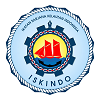KOROSI BAJA DI MUARA BARU JAKARTA DAN INDRAMAYU DENGAN SIMULASI PASANG SURUT UJI WET-DRY
Abstract
Kerusakan akibat korosi baja sebagai material Infrastruktur maritim diinvestigasi menggunakan uji simulasi Wet-Dry, kehilangan berat, energy dispersive X-Ray spectroscopy (EDS) dan X-ray diffraction (XRD) dalam media air laut Muara Baru Jakarta, Karangsong dan Eretan, Indramayu. Larutan kontrol digunakan sebagai perbandingan air laut alami yaitu 3,5% NaCl dan 5% NaCl. Hasil penelitian menyatakan bahwa kerusakan merata korosi terjadi pada Baja setelah ekspos. Ketahanan korosi meningkat cepat pada 7 hari pertama kemudian menurun seiring dengan meningkatnya waktu ekspos. Pengaruh nilai konduktivitas, salinitas dan total dissolved solid (TDS) terhadap proses korosi baja hampir sama di setiap waktu ekspos. Penurunan oksigen terlarut meningkatkan laju korosi pada 7 hari pertama, mengindikasikan pembentukan lapisan oksida sebagai penahan laju korosi lebih lanjut. Peran ion klorida yang tinggi, meningkatkan laju korosi setelah 7 hari waktu ekspos, mengganggu terbentuknya lapisan stabil oksida di permukaan logam. Gangguan tersebut menyebabkan laju korosi cenderung akan meningkat kembali. SenyawaγFeO(OH) (Lepidrococite) terbentuk sebagai senyawa utama produk korosi.
Kata kunci : Korosi, Infrastruktur, baja, Air laut,Salinitas, Oksigen terlarut .
ABSTRACT
The corrosive destruction of steel as material of maritime infrastructure had been investigated using simulated wet-dry test, loss weight, energy dispersive X-Ray spectroscopy (EDS) and X-ray diffraction (XRD) in seawater solutions of Muara Baru,Jakarta; Karangsong and Eretan regions, Indramayu. Controlled solution used as the comparison of natural seawater are 3,5% NaCl and 5% NaCl. The results shows that uniform corrosion took place on carbon steel after the exposure. The resistance of corrosion increases rapidly on the first 7 days, then decreases with increasing exposure time. The effect of conductivity, salinity and total dissolve solids (TDS) of test solutions for steel corrosion process was almost same at each interval of exposure time. The decrease of dissolved oxygen (DO) enhances corrosion rate on the first 7 days, which indicated the formation of oxide layer as the further barrier of corrosion process. The role of high concentration for chloride ion increases corrosion rate after 7 days of exposure time, which interfere the forming of stable oxide layer on the metal surface. That interference induces corrosion rate tends to increase again. The compound ofγFeO(OH) (Lepidrococite) formed as predominant corrosion product.
Keywords : Corrosion, Infrastructure, steel, seawater, salinity, dissolved oxygen
Full Text:
PDF (Bahasa Indonesia)References
Gadang Priyotomo, Lutviasari Nuraini, Siska Prifiharni, Sundjono. (2018). Corrosion Behavior of Mild Steel in Seawater from Karangsong & Eretan of West Java Refion, Indonesia. Jurnal Kelautan: Indonesian Journal of Marine Science and Technology, 11(2),184-191 .
Diego A. Fischer, Leslie Daille, Javiera Aguirre, Carlos Galarce, Francisco Armijo, Rodrigo De la Iglesia, Gonzalo Pizarro, Ignacio Vargas, Magdalena Walczak. (2016). Corrosion of Stainless Steel in Simulated Tide of Fresh Natural Seawater of South East Pacific. Int. J. Electrochem. Sci.,11, 6873 – 6885.
Robert E.Melchers. (2005). The effect of corrosion on the structural reliability of steel offshore structures. Corrosion Science, 47(10), 2391-2410.
Wu, J., Pang, K., Peng, D., Wu, J., Bao, Y., & Li, X. (2017). Corrosion Behaviors of Carbon Steels in Artificially Simulated and Accelerated Marine Environment. Int. J. Electrochem. Sci, 12, 1216-1231.
ASM. (1987). ASM Metals Handbook, vol. 13: Corrosion, 9th. ed., ASM International.
Bhosle,N.B, & Wagh,A.B.(1992). The effect of organic matter associated with the corrosion products on the corrosion of mild dteel in the arabian sea. Corrosion Science,33(5), 647-655.
Jones,D.A.(1992) Principles and Prevention of CORROSION. Macmilan Publishing Company
Durodola,B.M.,Olugbuyiro,J.A.O.,Moshood,S.A., Fayomi,O.S, & Popoola, A.P.I, (2011), Study of Influence of Zinc Plated Mild Steel Deterioration in Seawater Environment. Int. J. Electrochem. Sci., 6 , 5605 – 5616.
Al-Moubaraki, A.H., Al-Judaibi,A., & Asiri,M. (2015).Corrosion of C-Steel in the Red Sea: Effect of Immersion Time and Inhibitor Concentration. Int. J. Electrochem. Sci., 10, 4252 – 4278.
Temperley, T. G. (1965). Corrosion phenomena in the coastal areas of the Persian Gulf. Corrosion Science, 5(8), 581-589.
Wan Nik,W.B.Z., Rahman, F.M.M., & Rosliza, R.(2011). Corrosion Behavior of Mild Steel in Seawater from Two Different Sites of Kuala Terengganu Coastal Area. International Journal of Basic & Applied Sciences IJBAS-IJENS ,11(6), 75-80.
Nuraini, L., Prifiharni, S., & Priyotomo, G. (2017). The corrosivity and performance evaluation of antifouling paint exposed in seawater Muara Baru Port, Jakarta. In Journal of Physics: Conference Series (Vol. 817, No. 1, p. 012068). IOP Publishing.
Sundjono, S., Priyotomo, G., Nuraini, L., & Prifiharni, S. (2018). Corrosion Behavior of Mild Steel in Seawater from Northern Coast of Java and Southern Coast of Bali, Indonesia. Journal of Engineering and Technological Sciences, 49(6), 770-784.
Afolabi,A.S., Muhirwa,A.C., Abdulkareem, A.S., & Muzenda,E .(2014). Weight Loss and Microstructural Studies of Stressed Mild Steel in Apple Juice. Int. J. Electrochem. Sci , 9, 5895 – 5906.
Ismail,A. & Adan,N.H.(2014). Effect of Oxygen Concentration on Corrosion Rate of Carbon Steel in Seawater. American Journal of Engineering Research, 3(1), 64-67.
Muller, H., Boshoff, E. T., & Froneman, H. (2006). The corrosion behavior of carbon steel in natural and synthetic sea water. Journal of South African Institute of Mining and Metallurgy, 106, 585-592.
Eyu, G., Will, G., Dekkers, W., & MacLeod, J. (2016). Effect of dissolved oxygen and immersion time on the corrosion behaviour of mild steel in bicarbonate/chloride solution. Materials, 9(9), 748.
Zakowski, K., Narozny, M., Szocinski, M., & Darowicki, K. (2014). Influence of water salinity on corrosion risk—the case of the southern Baltic Sea coast. Environmental monitoring and assessment, 186(8), 4871-4879.
Martin,M.M. (2016). Industrial Chemical Process Analysis and Design, Elsevier.
Peinado-Guevara, H., Green-Ruíz, C., Herrera-Barrientos, J., Escolero-Fuentes, O., Delgado-Rodríguez, O., Belmonte-Jiménez, S., & Ladrón de Guevara, M. (2012). Relationship between chloride concentration and electrical conductivity in groundwater and its estimation from vertical electrical soundings (VESs) in Guasave, Sinaloa, Mexico. Ciencia e investigación agraria, 39(1), 229-239.
Boerlage, S. F. E. (2012). Measuring salinity and TDS of seawater and brine for process and environmental monitoring—which one, when?. Desalination and Water Treatment, 42(1–3), 222–230.
Al Dahaan, S., Al-Ansari, N., & Knutsson, S. (2016). Influence of groundwater hypothetical salts on electrical conductivity total dissolved solids. Engineering, 8(11), 823-830.
Rao, C. K., & Indusekhar, V. K. (1989). Distrubution of Certain Cations and Anions in Seaweeds and seawater of Saurastra coast and their geochemical significance. Indian Journal of Marine Sciences, 18. 37-42.
Song, Y., Jiang, G., Chen, Y., Zhao, P., & Tian, Y. (2017). Effects of chloride ions on corrosion of ductile iron and carbon steel in soil environments. Scientific reports, 7(1), 6865.
Shengxi Li and L. H. Hihara.(2014). Aerosol Salt Particle Deposition on Metals Exposed to Marine Environments: A Study Related to Marine Atmospheric Corrosion. Journal of The Electrochemical Society, 161 (5), C268-C275.
DOI: https://doi.org/10.21107/jk.v12i1.4800
Refbacks
- There are currently no refbacks.

This work is licensed under a Creative Commons Attribution 4.0 International License.

Jurnal Kelautan by Program Studi Ilmu Kelautan is licensed under a Creative Commons Attribution 4.0 International License.
Published by: Department of Marine Sciences, Trunojoyo University of Madura













